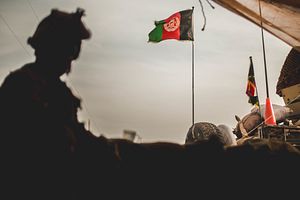In Afghanistan’s Faryab province, protesters stormed the national intelligence agency’s offices in the city of Maimana, looted the provincial governor’s compound, and burned several vehicles. The protests happened after the arrest of a powerful warlord and commander, Nezamuddin Qaisari, who is loyal to Vice President Abdul Rashid Dostum. Qaisari was arrested after he allegedly threatened to kill people at a provincial security meeting.
Qaisari is the provincial representative of fellow ethnic Uzbeks. He is closely affiliated with Dostum, who fled to Turkey last year after he was accused of being involved in the rape and torture of a political rival. Dostum warned the removal of Qaisari could worsen insecurity in Faryab, where government forces are fighting the Taliban and Islamic State-Khorasan Province (ISKP).
Ethnic warlords and strongmen are the product of the last four decades of war and one of the worst legacies of the United States’ long war in Afghanistan. These figures remain a strong challenge for the central government. After the Soviet occupation ended, a group of strongmen and warlords with personal militias stepped into the vacuum, gaining immense influence and power. The warlords created private militias and have been involved in heinous crimes and human rights violations ever since. Using government resources and positions, they have been ruling with impunity for decades.
Warlords remain a barrier Afghanistan’s fledgling democracy and accountability, blocking a new generation from leading the country toward progress and development. They are responsible for killings, beatings, abductions, extortion, land seizures, illegal mining, drug trafficking, and in some cases joining hands with the Taliban where there is mutual interest. In short, these warlords have become a major problem for the country.
The rise and endurance of the warlords is a legacy of the U.S. war in Afghanistan. The majority of the current warlords gained prominence in late 2001 while fighting against the Taliban regime. With the U.S.-supplied funds and weapons, coupled with the collapse of the Taliban regime, these warlords were able to control and influence the nation’s security forces and government ministries.
The government provided them with influential positions and they got subcontracts from U.S. companies. Many received funds from the United States and Western countries to work alongside U.S. and NATO forces to fight against the Taliban and al-Qaeda, further increasing their influence in Afghan politics. Thus, with American tax payer’s money and a weak Afghan central government’s blessing, the warlords thrived.
They largely used their official positions to cement their own authority in their respective territories and have enriched themselves through illegal money. From ministerial posts to civilian positions, from the security sector to lucrative customs, they have influence everywhere.
This is a big hurdle facing the Western-educated technocrats keen to transform Afghanistan from a traditional conservative society into a modern and progressive era.
President Ashraf Ghani, a U.S.-educated former World Bank official, is widely seen as committed to altering old notion of power. He has been able to either fire or marginalize some of the powerful warlords, such those in Faryab, Uruzgan, Farah, and Badakhshan. However, whenever there has been a crackdown or an effort to marginalize warlords, they have issued warnings of havoc and civil war.
Bizarrely, many of the most prominent warlords occupy top positions in the government and at the same time work against the government. Some have held or continue to hold high-level positions: vice president, ministerial positions, or governors of important provinces. They serve both in the government and in an opposition role at the same time, thus bringing the legitimacy of the government under question. Stirring ethnic and linguistic hatred among society and playing the blame game has become a common practice for them to remain in power.
For instance, Mohamad Mohaqeq, second vice president and warlord, threatened the central government when one of his introduced ministers, Razaq Wahidi, was tried this week for alleged corruption. He accused the government of favoring ex-Finance Minister Eklil Hakimi, who resigned from his position and was appointed as an adviser to the president in international affairs.
Hakimi, a former ambassador to the United States, China, and Japan was considered a key interlocutor with Western partners who succeeded in bringing more donor aid to the country. Hakimi, before his resignation, was one of the most trusted ministers of Ghani’s cabinet. Similarly, three weeks back, Minister of Urban Development and Housing Syed Mansoor Naderi, another Western-oriented liberal technocrat, had resigned, and Ali Ahmad Osmani, the minister of energy and water was fired by Ghani.
In addition to the complexity of war, Afghanistan politics remains very complicated. The government is not only fighting against ISKP, the Taliban, and around 20 regional and global terrorist groups, it has to deal with regional strongmen and warlord who are just as much of a threat as the Taliban are. Warlords and strongmen with armed militias are a serious threat to the country’s stability and have to be marginalized in order to move the nation into a new era of democracy. Without robust progress in governance, and strengthening democratic institutions, the security gains made so far and momentum against ISKP and Taliban insurgents will be lost.
Afghanistan is in need of vast amount of Western diplomatic capital to rein in the warlords. They remain not only a problem for Afghanistan’s relatively new democratic system but also a national security threat.
Ahmad Shah Katawazai is an Afghan diplomat with the Ministry of Foreign Affairs and a national security expert. Katawazai is a published writer as well as a Johns Hopkins University and American University Alumni. The views expressed are his own. Follow him on Twitter at @askatawazai

































